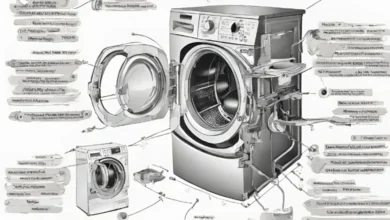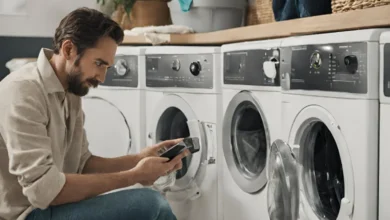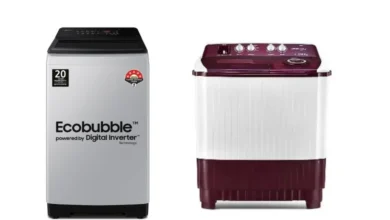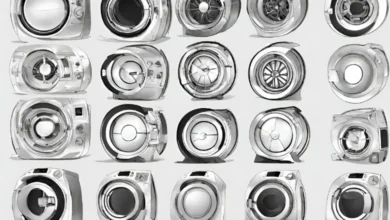Optimizing Washing Machine Performance Through Advanced Load Monitoring Devices
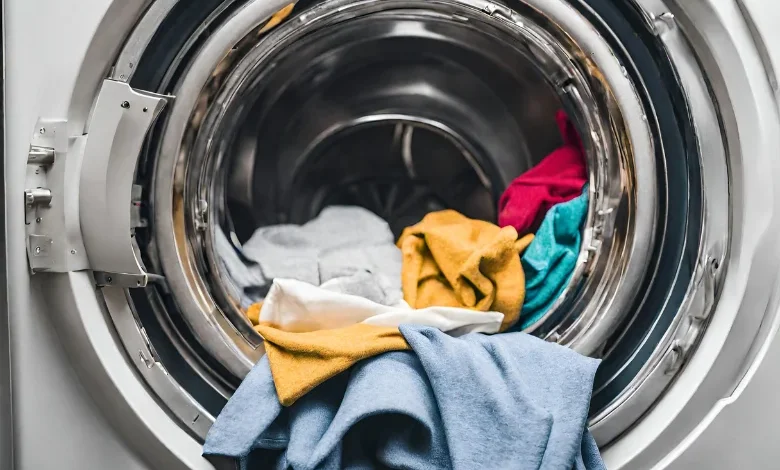
Washing machines have undergone significant transformations over the years, not only in design and features but also in terms of efficiency and environmental impact. The integration of sophisticated load monitoring devices has been instrumental in driving these advancements, playing a pivotal role in optimizing washing machine performance, ensuring energy and water efficiency, and enhancing the overall user experience.
Load Sensors: Enhancing Efficiency with Precision Measurement
Understanding Load Sensors:
At the heart of modern washing machines lies the revolutionary technology of load sensors. These sensors are meticulously engineered to measure the weight of the laundry load within the drum. The primary objective is to empower washing machines to dynamically adjust their operation based on the specific size of the load, thereby promoting more efficient water and energy usage.
Dynamic Load Adjustment:
The implementation of load sensors introduces a dynamic element to the washing process. These sensors enable washing machines to adapt various parameters throughout the washing cycle based on real-time load measurements. Water levels, detergent quantities, and wash cycle durations are precisely calibrated to match the unique characteristics of each load. This not only conserves resources but ensures a thorough cleaning process, irrespective of load size.
Advanced Load Prediction:
In cutting-edge washing machines, load sensors are evolving to incorporate advanced load prediction algorithms. By analyzing historical data and user patterns, these systems can anticipate the load size even before the cycle begins. This predictive capability further refines the adjustments made during the wash, contributing to an even more tailored and resource-efficient laundry experience.
Vibration Sensors: A Balancing Act for Smooth Operation
The Role of Vibration Sensors:
Excessive vibrations during the spin cycle can not only result in a noisy operation but can also lead to potential damage to the washing machine and its surroundings. Vibration sensors come into play as the silent guardians of a seamless laundry experience, detecting irregularities in load distribution within the drum.
Balancing for Optimal Performance:
Once vibrations are detected, washing machines equipped with vibration sensors embark on a precision balancing act. This process ensures that the spin cycle operates with minimal vibrations and noise. The outcome is not only a quieter laundry session but also an extended lifespan for the appliance, as the stress on components is significantly reduced.
Adaptive Vibration Control:
In the pursuit of continuous improvement, some washing machines are now incorporating adaptive vibration control. These systems not only detect imbalances but actively adjust the drum rotation speed and distribution of the load during the spin cycle. This level of adaptability ensures a consistently smooth and quiet operation, regardless of the contents in the drum.
Also Read: Best Washing Machine in India
Temperature Sensors: Precision Control for Effective Cleaning
Maintaining Optimal Water Temperature:
Water temperature is a critical factor influencing the efficacy of the washing process. Temperature sensors embedded in washing machines play a pivotal role in maintaining the desired water temperature throughout various wash cycles.
Fabric-Specific Temperature Profiles:
Different fabrics demand different water temperatures for optimal cleaning without causing damage. Temperature sensors enable washing machines to dynamically adapt to these fabric-specific requirements. Delicate fabrics benefit from a gentle wash at lower temperatures, while heavily soiled items can undergo a more robust cleaning process at higher temperatures. This level of precision not only enhances cleaning performance but also preserves the integrity of the clothing.
Energy-Efficient Heating:
Modern temperature sensors also contribute to the overall energy efficiency of washing machines. By precisely controlling the heating element, these sensors ensure that energy is utilized only when needed. This not only reduces operational costs for users but aligns with a more sustainable approach to laundry.
Current and Power Monitoring: Efficient Resource Management
Real-time Energy Consumption Analysis:
Current and power monitoring devices represent the data-driven backbone of efficient washing machines. These devices provide real-time insights into the appliance’s energy consumption during different cycles, offering a wealth of information for both manufacturers and end-users.
Optimizing Energy Usage:
Empowered by data from current and power monitoring devices, washing machines can fine-tune their energy usage. Smart algorithms analyze consumption patterns and adjust power levels during different phases of the wash cycle, ensuring that only the necessary amount of energy is expended. This not only leads to cost savings for users but also positions washing machines as more environmentally responsible appliances.
User-Friendly Energy Dashboards:
In some modern washing machines, manufacturers are taking transparency to the next level by incorporating user-friendly energy dashboards. These digital interfaces provide consumers with detailed breakdowns of energy consumption, allowing them to make informed decisions about energy-efficient wash cycles. The integration of such dashboards not only empowers users but also fosters a greater sense of environmental responsibility.
Pressure Sensors: Precise Water Management
Ensuring Proper Water Levels:
Pressure sensors stand as guardians of efficient water management within washing machines. Their primary role is to monitor and regulate water levels inside the drum, ensuring that the right amount of water is used for each load.
Intelligent Water Distribution:
By precisely regulating water levels based on load size and cycle requirements, washing machines equipped with pressure sensors optimize water distribution. This targeted approach not only enhances cleaning performance but also contributes significantly to water conservation. In an era where water scarcity is a growing concern, these devices play a pivotal role in responsible resource management.
Water Recycling Initiatives:
In some advanced washing machines, pressure sensors are part of broader water recycling initiatives. These initiatives aim to repurpose and reuse water from previous cycles, further minimizing water wastage. Such innovative approaches not only align with sustainability goals but also position washing machines as integral components of eco-friendly households.
Inlet Valve Control: Minimizing Water Wastage
Smart Water Inlet Mechanism:
Inlet valve control devices represent a crucial aspect of minimizing water wastage in washing machines. These devices are engineered to regulate the flow of water into the appliance, adapting the water inflow based on the specific requirements of the load and the selected wash cycle.
Precision Water Usage in Action:
The implementation of smart water inlet mechanisms translates to precise water usage tailored to the characteristics of each load. This not only minimizes water wastage but also ensures that the right amount of water is available at each phase of the washing process. Users benefit from reduced water bills, and the environment benefits from a more sustainable approach to laundry.
Future Trends:
As manufacturers continue to innovate, future iterations of washing machines may see even more sophisticated water inlet control systems. These could include real-time water quality analysis, enabling washing machines to adjust not only the quantity but also the quality of water used during each cycle. Such advancements would mark another step toward more sustainable and water-efficient laundry practices.
Microcontrollers and Smart Technologies: The Brain Behind the Operation
The Role of Microcontrollers:
Microcontrollers serve as the central nervous system of modern washing machines, orchestrating the harmonious interplay of various load monitoring devices. These miniature computing powerhouses are responsible for processing data in real-time and making dynamic adjustments for optimal performance.
Real-time Adaptations:
Equipped with microcontrollers, washing machines can analyze data from a plethora of sensors – load sensors, vibration sensors, temperature sensors, and more. This real-time analysis enables the machine to adapt seamlessly to changing conditions, ensuring an efficient and effective cleaning process for each load.
Smart Connectivity:
Beyond the confines of traditional laundry routines, washing machines with microcontrollers often boast smart connectivity features, marking a paradigm shift in user interaction with household appliances. The integration of Wi-Fi capabilities and mobile app support allows users to remotely monitor and control their washing machines.
Remote Monitoring and Control:
Smart technologies enable users to receive real-time updates on the progress of laundry cycles directly on their smartphones or tablets. This level of connectivity offers unparalleled convenience, allowing users to plan their day around laundry activities without being physically present near the machine.
Notifications and Alerts:
Microcontrollers, in conjunction with smart technologies, can send notifications and alerts to users. Whether the wash cycle is complete, or if any issues are detected, users receive timely notifications, providing a seamless and stress-free laundry experience. This not only enhances user convenience but also facilitates quick responses to potential problems.
Energy Consumption Insights:
Some advanced washing machines with microcontrollers provide detailed insights into energy consumption patterns. Users can access comprehensive reports on how much energy each wash cycle consumes, empowering them to make informed decisions about energy-efficient practices. This transparency promotes a sense of accountability in energy usage.
Machine Learning and Predictive Maintenance:
The capabilities of microcontrollers extend to machine learning algorithms that enable predictive maintenance. By analyzing historical usage patterns and sensor data, the washing machine can predict potential issues before they escalate. This proactive approach reduces the risk of breakdowns, extends the lifespan of the appliance, and minimizes the need for costly repairs.
Energy Efficiency Ratings:
Microcontrollers play a crucial role in the determination of energy efficiency ratings for washing machines. These ratings, often displayed prominently on appliances, provide consumers with valuable information about the energy consumption levels of the machine. Informed by data from load monitoring devices, these ratings guide consumers towards environmentally friendly and cost-effective choices.
User Experience and Environmental Impact
Balancing User Experience:
The amalgamation of load monitoring devices, microcontrollers, and smart technologies in modern washing machines is designed not only for efficiency but also to enhance the overall user experience. From adaptive wash cycles to remote control capabilities, every aspect is crafted with the user in mind.
User-Friendly Interfaces:
Manufacturers are investing in intuitive user interfaces to ensure that the advanced features of washing machines are accessible to all users. Touchscreens, intuitive buttons, and voice command integrations are becoming commonplace, making it easier for users to navigate and customize their laundry experience.
Customizable Wash Profiles:
Load monitoring devices, when combined with microcontrollers, allow for the creation of customizable wash profiles. Users can tailor wash cycles to specific fabric types, stain levels, or personal preferences. This level of customization ensures that users have control over the washing process, catering to their unique needs.
Environmental Considerations:
Beyond the convenience and efficiency, the environmental impact of washing machines cannot be overstated. Load monitoring devices contribute significantly to resource conservation, but their collective impact extends to a broader sustainability narrative.
Reduced Water Consumption:
The precise regulation of water levels by pressure sensors, coupled with adaptive water inlet control mechanisms, results in reduced water consumption. In regions grappling with water scarcity, these innovations are not only beneficial for users but also align with global efforts to promote responsible water usage.
Energy Efficiency and Carbon Footprint:
The optimization of energy usage, guided by current and power monitoring devices, contributes to the overall energy efficiency of washing machines. Reduced energy consumption translates to a lower carbon footprint, aligning with the growing emphasis on eco-friendly appliances.
Sustainable Material Choices:
In the broader context of environmental responsibility, manufacturers are increasingly considering sustainable material choices in the construction of washing machines. From recycled plastics to energy-efficient components, the industry is making strides toward a more sustainable manufacturing ecosystem.
Looking Ahead: Future Trends in Laundry Technology
Integration of Artificial Intelligence (AI):
The future of washing machines holds exciting possibilities with the integration of artificial intelligence (AI). AI algorithms could take load prediction to new heights, learning from user behavior and adapting to changing laundry patterns. This could result in even more efficient resource utilization and customized wash cycles.
Blockchain for Transparency:
Blockchain technology may find applications in ensuring transparency in the lifecycle of washing machines. From sourcing raw materials to manufacturing and eventual recycling, blockchain can provide an immutable record, assuring consumers of the sustainability credentials of their appliances.
Water Recycling Innovations:
Advancements in water recycling technologies could see washing machines incorporating systems that capture and treat wastewater for reuse in subsequent cycles. This closed-loop approach not only conserves water but also addresses concerns about water quality and availability.
Collaboration with Smart Homes:
The future landscape of laundry technology might witness increased collaboration between washing machines and other smart home devices. Seamless integration with smart home ecosystems could lead to more streamlined routines, such as coordinating with energy-efficient heating systems or syncing with home energy management platforms.
Enhanced Durability and Repairability:
As consumer demand for sustainable products grows, manufacturers may focus on enhancing the durability and repairability of washing machines. Designing appliances with easily replaceable components and offering repairability features could extend the lifespan of the machines, reducing electronic waste.
Conclusion: A Holistic Approach to Laundry
In conclusion, the journey of washing machines from simple mechanical devices to intelligent, connected appliances reflects a commitment to balancing performance with sustainability. Load monitoring devices, microcontrollers, and smart technologies work in tandem to create a holistic approach to laundry.
Users, armed with information about their appliances’ energy and water usage, become empowered to make environmentally conscious choices. The transparency provided by load monitoring devices and smart interfaces fosters a sense of responsibility, transforming the act of doing laundry into a thoughtful and sustainable process.
The evolution of washing machines is not just about technological advancements but also about reshaping industry practices. Manufacturers, guided by data from load monitoring devices, are adopting sustainable materials, energy-efficient manufacturing processes, and transparent supply chains, contributing to a more responsible and ethical industry.
As we look ahead, the convergence of AI, blockchain, and other emerging technologies promises even more exciting developments in laundry technology. The washing machine is not merely a household appliance; it is a testament to how innovation can shape everyday life, making it more efficient, sustainable, and interconnected.
In embracing these technologies, both manufacturers and consumers become agents of change, contributing to a future where laundry is not just a chore but a mindful and sustainable practice. Washing machines, equipped with advanced load monitoring devices, stand as symbols of the harmonious blend of technological innovation and everyday practicality, making our lives more comfortable, efficient, and environmentally responsible.
